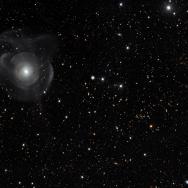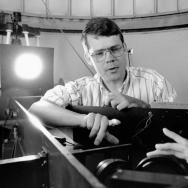The Dark Energy Survey collaboration announced it has created the largest-ever maps of the distribution and shapes of galaxies, tracing both ordinary and dark matter in the universe out to a distance of more than 7 billion light-years.
The analysis, which includes the first three years of data from the survey, is consistent with predictions from the current best model of the universe. Nevertheless, there remain hints from the Dark Energy Survey and other experiments that matter in the current universe is a few percent less “clumpy” than predicted.
The Dark Energy Survey, an international collaboration coordinated through the University of Chicago-affiliated Fermi National Accelerator Laboratory, surveyed almost one-eighth of the entire sky over six years, cataloguing hundreds of millions of objects. The new results announced May 27 draw on data from the first three years to create the most precise maps yet of the distribution of galaxies in the universe at relatively recent epochs.
Since the Dark Energy Survey studied nearby galaxies as well as those billions of light-years away, its maps provide both a snapshot of the current large-scale structure of the universe and a “movie” of how that structure has evolved over the course of the past 7 billion years.
“We’re trying to understand the universe as a whole, so you need that kind of large-scale dataset,” said Judit Prat, a postdoctoral researcher with the University of Chicago who analyzed weak gravitational lensing as captured by the Dark Energy Survey.
Cosmic clumps
According to our best understanding, ordinary matter makes up only about 5% of the universe. Dark energy accounts for about 70%. The last 25% is dark matter, whose gravitational influence binds galaxies together. Both dark matter and dark energy remain invisible and mysterious, but the Dark Energy Survey seeks to illuminate their natures by studying how the competition between them shapes the large-scale structure of the universe over cosmic time.
To quantify the distribution of dark matter and the effect of dark energy, the Dark Energy Survey relied on two main phenomena. First, galaxies are not distributed randomly throughout space, but rather form a weblike structure due to the gravity of dark matter. The Dark Energy Survey measured how this cosmic web has evolved over the history of the universe.
Second, the Dark Energy Survey detected the signature of dark matter through a technique called weak gravitational lensing. As light from a distant galaxy travels through space, the gravity of both ordinary and dark matter can bend it, resulting in a distorted image of the galaxy as seen from Earth. By studying how the apparent shapes of distant galaxies are aligned with each other and with the positions of nearby galaxies along the line of sight, the Dark Energy Survey scientists inferred the spatial distribution (or “clumpiness”) of the dark matter in the universe.
Next, to test cosmologists’ current model of the universe, Dark Energy Survey scientists compared their results with measurements from the European Space Agency’s orbiting Planck observatory.
Planck looks for a type of light called the cosmic microwave background in order to peer back to the early universe, just 400,000 years after the Big Bang. Then scientists feed that into the current best model of our understanding of the universe, which predicts how the dark matter should evolve to the present. If the Dark Energy Survey’s observations don’t match this prediction, there is possibly an undiscovered aspect to the universe.
While there have been persistent hints from the Dark Energy Survey and several previous galaxy surveys that the current universe is a few percent less clumpy than predicted—an intriguing find worthy of further investigation—the recently released results are consistent with the prediction.
“The curious thing is that with every new set of observations, we confirm the standard cosmological model, and yet we have no real explanation for what dark energy and dark matter—a major part of that model—really are,” said Lucas Secco, a postdoctoral researcher with UChicago who co-led the analysis of cosmic shear in the dataset. “It’s a strange situation to be in.”
Data wrangling on a different level
Analyzing the massive amounts of data collected by the Dark Energy Survey was a formidable undertaking. The team began by analyzing just the first year of data, which was released in 2017. That process prepared the researchers to use more sophisticated techniques for analyzing the larger data set.
For example, calculating the redshift of a galaxy—the change in light’s wavelength due to the expansion of the universe—is a key step toward measuring how both galaxy clustering and weak gravitational lensing change over cosmic history. The redshift of a galaxy is related to its distance, which allows the clustering to be characterized in both space and time.
“There was significant improvement in how to calibrate the redshift distributions of the galaxy samples,” said Prat. “This was a huge effort that people put a lot of work into. We now have a method that nobody has used before, and it’s very robust.”
The Dark Energy Survey concluded observations of the night sky in 2019. With the experience of analyzing the first half of the data, the team is now prepared to handle the complete data set. The final analysis is expected to paint an even more precise picture of the dark matter and dark energy in the universe. And the methods developed by the team have paved the way for future sky surveys to probe the mysteries of the cosmos.
“The collaboration is remarkably young. It’s tilted strongly in the direction of postdocs and graduate students who are doing a huge amount of this work,” said the Dark Energy Survey Director and spokesperson Prof. Rich Kron. “That’s really gratifying. A new generation of cosmologists are being trained using the Dark Energy Survey.”
The Dark Energy Survey is a collaboration of more than 400 scientists from 25 institutions in seven countries. For more information about the survey, please visit the experiment’s website.
Funding for the DES Projects has been provided by the U.S. Department of Energy, the U.S. National Science Foundation, the Ministry of Science and Education of Spain, the Science and Technology Facilities Council of the United Kingdom, the Higher Education Funding Council for England, the National Center for Supercomputing Applications at the University of Illinois at Urbana-Champaign, the Kavli Institute of Cosmological Physics at the University of Chicago, Funding Authority for Funding and Projects in Brazil, Carlos Chagas Filho Foundation for Research Support of the State of Rio de Janeiro, Brazilian National Council for Scientific and Technological Development and the Ministry of Science and Technology, the German Research Foundation and the collaborating institutions in the Dark Energy Survey.
—Adapted from an article first published by Fermi National Accelerator Laboratory.

